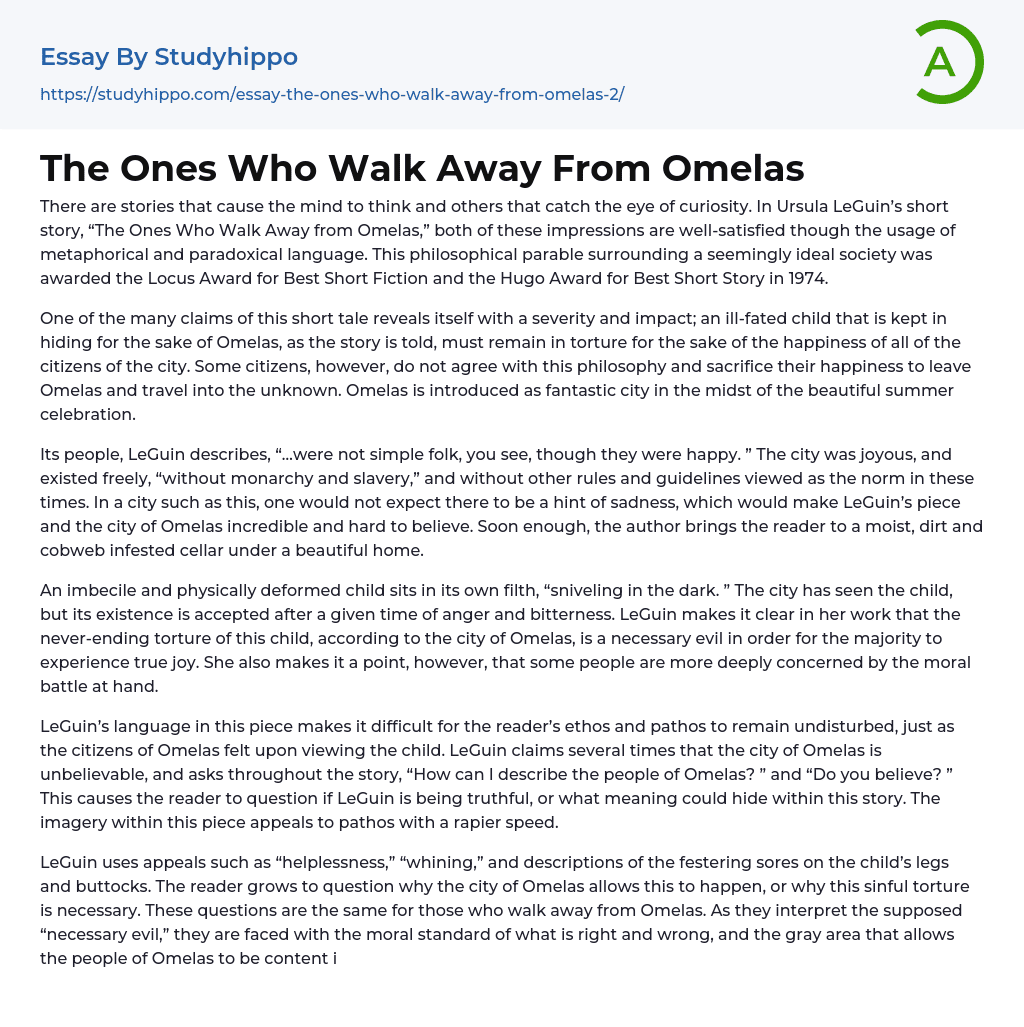There are stories that cause the mind to think and others that catch the eye of curiosity. In Ursula LeGuin’s short story, “The Ones Who Walk Away from Omelas,” both of these impressions are well-satisfied though the usage of metaphorical and paradoxical language. This philosophical parable surrounding a seemingly ideal society was awarded the Locus Award for Best Short Fiction and the Hugo Award for Best Short Story in 1974.
One of the many claims of this short tale reveals itself with a severity and impact; an ill-fated child that is kept in hiding for the sake of Omelas, as the story is told, must remain in torture for the sake of the happiness of all of the citizens of the city. Some citizens, however, do not agree with this philosophy and sacrifice their happiness
...to leave Omelas and travel into the unknown. Omelas is introduced as fantastic city in the midst of the beautiful summer celebration.
Its people, LeGuin describes, “…were not simple folk, you see, though they were happy. ” The city was joyous, and existed freely, “without monarchy and slavery,” and without other rules and guidelines viewed as the norm in these times. In a city such as this, one would not expect there to be a hint of sadness, which would make LeGuin’s piece and the city of Omelas incredible and hard to believe. Soon enough, the author brings the reader to a moist, dirt and cobweb infested cellar under a beautiful home.
An imbecile and physically deformed child sits in its own filth, “sniveling in the dark. ” The city has seen the child, bu
its existence is accepted after a given time of anger and bitterness. LeGuin makes it clear in her work that the never-ending torture of this child, according to the city of Omelas, is a necessary evil in order for the majority to experience true joy. She also makes it a point, however, that some people are more deeply concerned by the moral battle at hand.
LeGuin’s language in this piece makes it difficult for the reader’s ethos and pathos to remain undisturbed, just as the citizens of Omelas felt upon viewing the child. LeGuin claims several times that the city of Omelas is unbelievable, and asks throughout the story, “How can I describe the people of Omelas? ” and “Do you believe? ” This causes the reader to question if LeGuin is being truthful, or what meaning could hide within this story. The imagery within this piece appeals to pathos with a rapier speed.
LeGuin uses appeals such as “helplessness,” “whining,” and descriptions of the festering sores on the child’s legs and buttocks. The reader grows to question why the city of Omelas allows this to happen, or why this sinful torture is necessary. These questions are the same for those who walk away from Omelas. As they interpret the supposed “necessary evil,” they are faced with the moral standard of what is right and wrong, and the gray area that allows the people of Omelas to be content in their own lives.
In order to escape this moral dilemma, and to not prosper from a defenseless being’s wasted life, they leave the incredible city for better or for worse. “The Ones
Who Walk Away from Omelas,” by Ursula LeGuin, is a piece of literature that is profound for its length through its allegorical nature and paradoxical undertones. The child, a representation of the beastly chaos and pain of the city, allows the majority of the city to live at peace with their lives. Others, while they do not stand up to the city, leave for the hope of escaping the thought of Omelas and the secret the joyous city feeds on.
- Book Summary essays
- Metaphor essays
- Reader essays
- Rhyme essays
- Literary devices essays
- Villain essays
- Books essays
- Genre essays
- Literary Criticism essays
- Writer essays
- Protagonist essays
- Simile essays
- Poem essays
- Book Report essays
- Book Review essays
- Greek Mythology essays
- Plot essays
- Tragic Hero essays
- Coming of Age essays
- Play essays
- Rhetoric essays
- Rhetorical Question essays
- Translation essays
- Understanding essays
- Reason essays
- Character essays
- Letter essays
- American Literature essays
- Literature Review essays
- Utopia essays
- Poetry Analysis essays
- Dante's Inferno essays
- Between The World and Me essays
- Incidents in The Life of a Slave Girl essays
- Flowers for Algernon essays
- Myth essays
- Everyday Use essays
- Boo Radley essays
- Genesis essays
- Richard iii essays
- Alice in Wonderland essays
- On the road essays
- Ozymandias essays
- The Nightingale essays
- Holden Caulfield essays
- Animal Farm essays
- 1984 essays
- A Hanging essays
- Shooting An Elephant essays
- A Tale Of Two Cities essays




